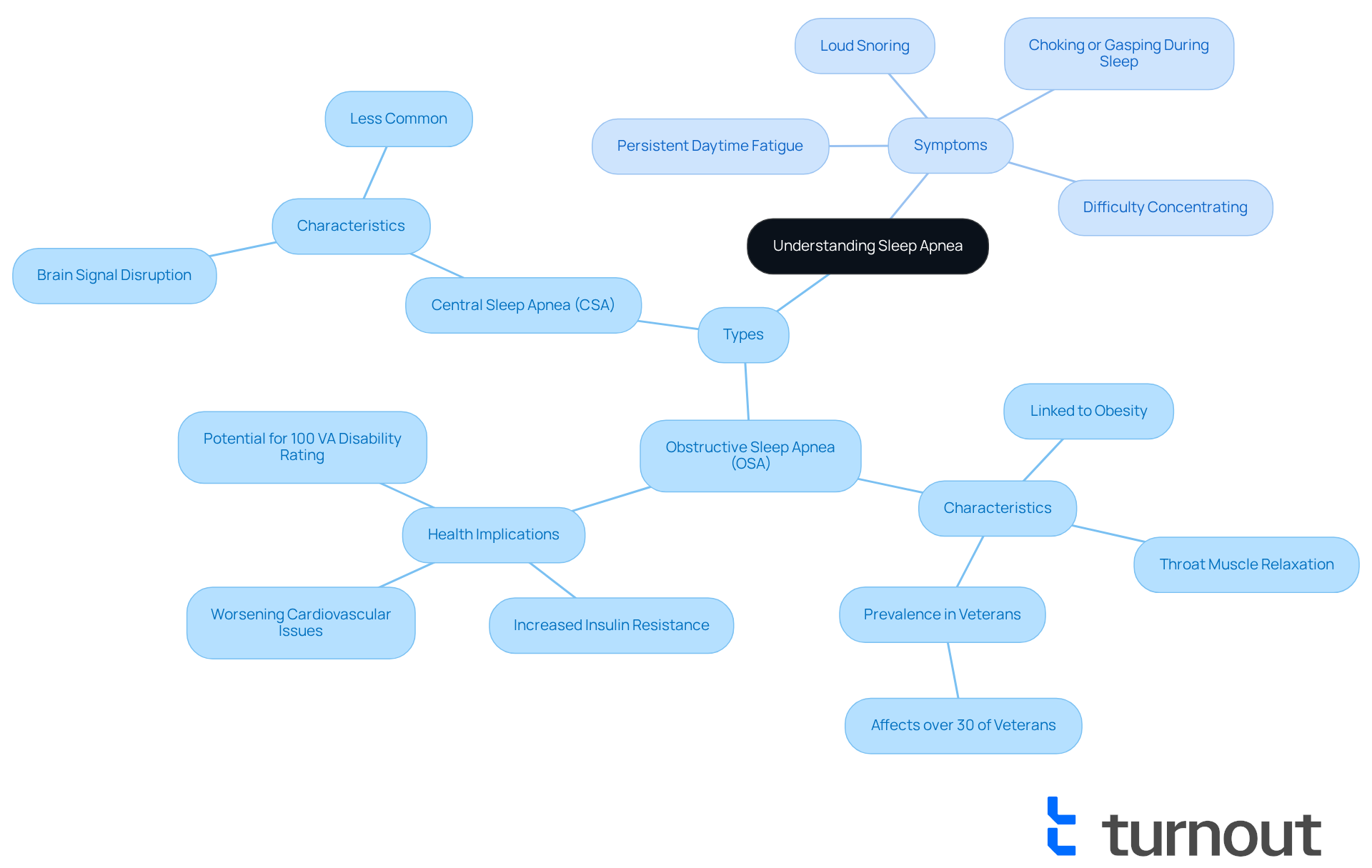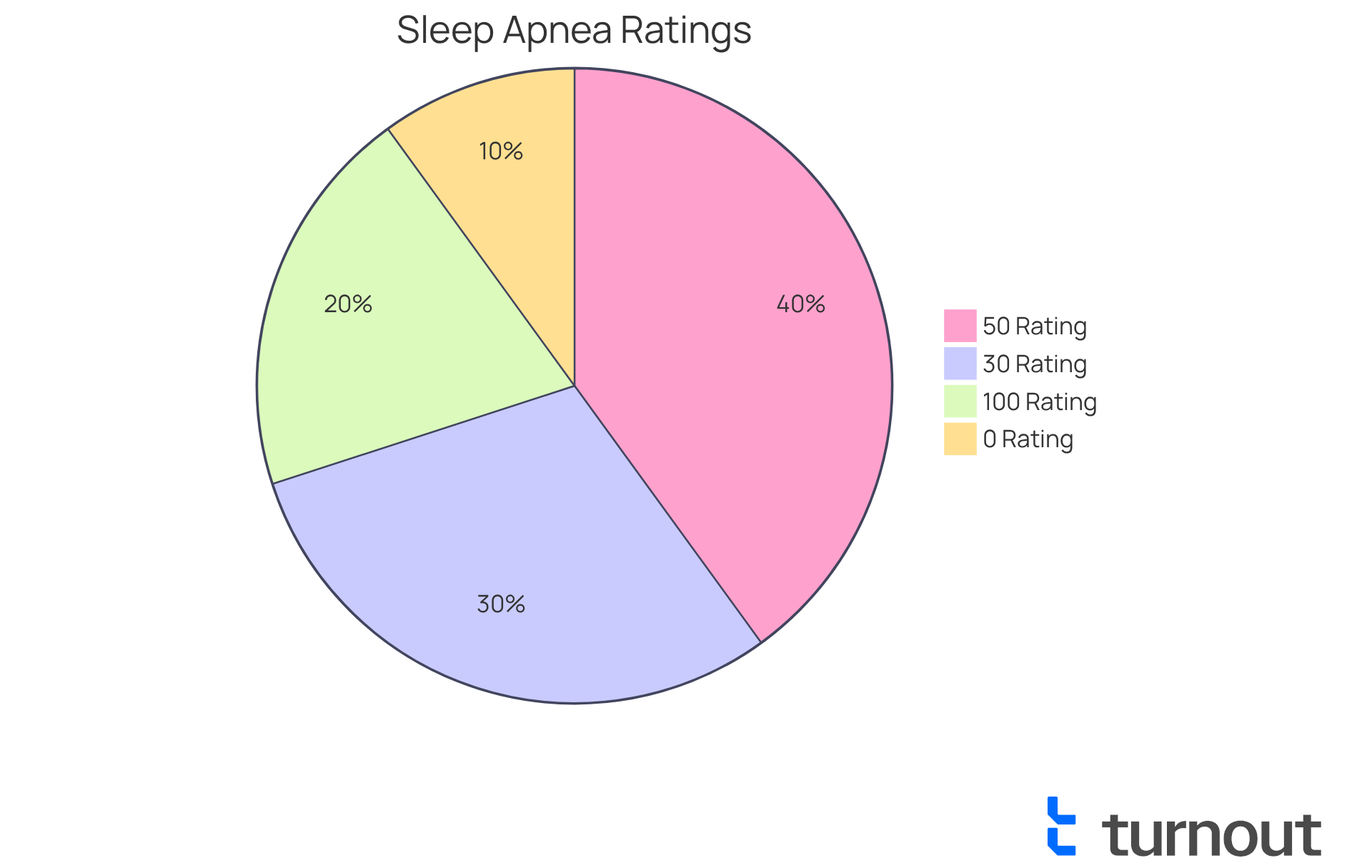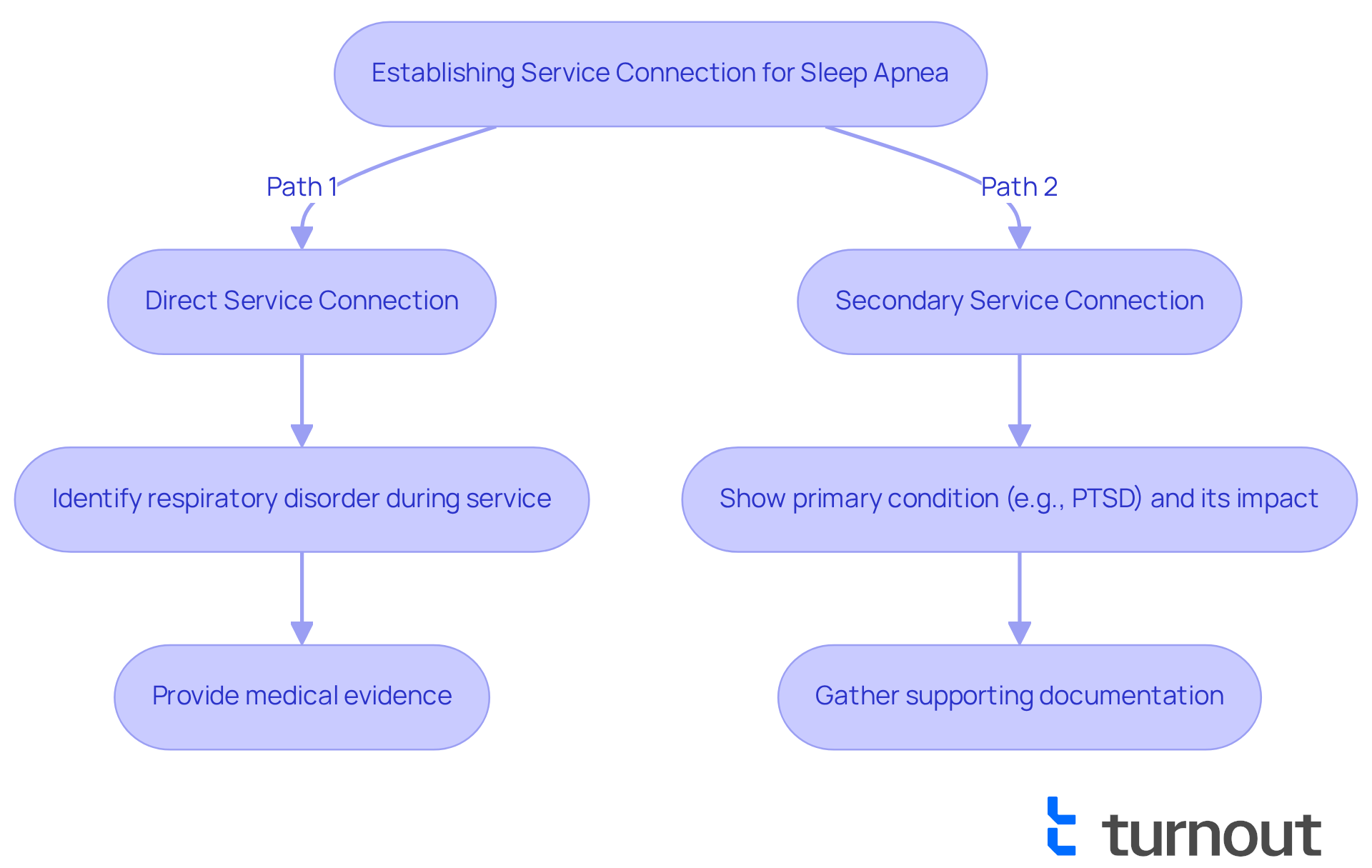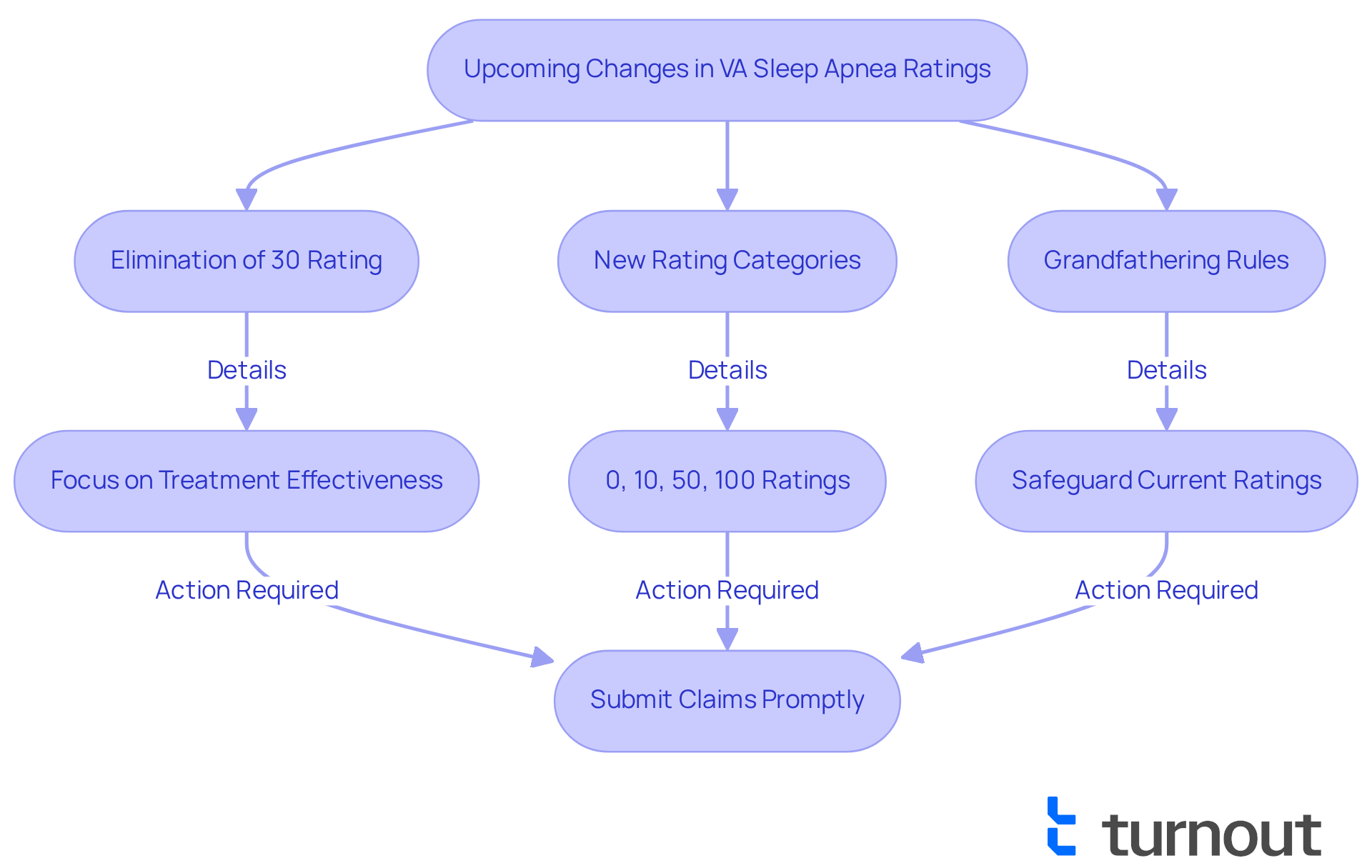Overview
If you are a veteran struggling with sleep apnea, know that you are not alone. This condition can indeed be recognized as a VA disability, but it's important to understand that establishing a service connection is essential to qualify for benefits. We understand that navigating this process can be overwhelming.
Comprehensive medical documentation is crucial. You will need evidence that links your sleep apnea to your military service or related health issues. This documentation is key to successfully navigating the claims process and determining your eligibility for disability ratings.
Remember, you're not just a number in a system. Your experiences matter, and there are resources available to support you. We’re here to help you every step of the way. Take action today and gather the necessary information to advocate for your health and well-being.
Introduction
Sleep apnea is a condition that disrupts breathing during sleep, and it poses significant health risks, especially for veterans who may experience it at higher rates due to factors like obesity and service-related stress. We understand that navigating this issue can feel overwhelming. Understanding whether sleep apnea qualifies as a VA disability is crucial for veterans seeking benefits. It can directly impact their quality of life and access to necessary healthcare.
However, the complexities of the claims process and the upcoming changes in VA rating criteria raise important questions. How can veterans effectively navigate these challenges to secure the support they deserve? You're not alone in this journey, and we're here to help you find the answers.
Understanding Sleep Apnea: Types and Symptoms
Sleep apnea is a condition that can disrupt your breathing during sleep, impacting your overall health and well-being. We understand that this can be a challenging issue, and it's important to recognize the two primary types:
-
Obstructive Sleep Apnea (OSA): This is the most common type, occurring when the throat muscles relax too much during sleep, causing an obstruction in the airway. It's often linked to obesity, a significant risk factor among former military personnel. Research indicates that obstructive respiratory issues affect over 30% of veterans receiving treatment each year at Bay Pines VA, highlighting its prevalence in this community.
-
Central Sleep Apnea (CSA): This less common type arises when the brain fails to send the right signals to the muscles that control breathing, leading to disrupted sleep patterns.
Common signs of this disorder include loud snoring, choking or gasping during sleep, persistent daytime fatigue, and difficulty concentrating. It's crucial for veterans to recognize these symptoms, especially when considering if sleep apnea is a VA disability, as they can overlap with other conditions like chronic fatigue syndrome.
Research suggests that if left unmanaged, sleep apnea can worsen various health issues, including cardiovascular diseases, diabetes, and mental health conditions. For example, untreated OSA can increase insulin resistance, raising the risk of developing type 2 diabetes. Additionally, untreated breathing disturbances during sleep may exacerbate cardiovascular problems, leading to inquiries about whether sleep apnea is a VA disability if end-organ damage occurs.
It's essential for veterans to understand that a diagnosis of a sleep disorder alone does not guarantee that sleep apnea is a VA disability. The VA assesses respiratory disturbances to determine if sleep apnea is a VA disability, rating them at 0%, 30%, 50%, or 100% based on severity and treatment needs. To qualify, it must be established whether sleep apnea is a VA disability that is connected to military service or other service-related issues. Collecting comprehensive medical documentation, including an official diagnosis from a sleep study, is vital for supporting your claims. We encourage veterans to document persistent symptoms such as fatigue, headaches, and difficulty concentrating to strengthen their applications. Furthermore, coexisting conditions like PTSD, COPD, and depression can complicate issues related to obstructive breathing disturbances, emphasizing the importance of providing thorough documentation and evidence. You are not alone in this journey; we're here to help.

VA Disability Ratings for Sleep Apnea: Evaluation Criteria
The VA understands that navigating disability claims, particularly regarding whether is sleep apnea a VA disability, can be challenging. These claims are assessed during rest to evaluate whether is sleep apnea a VA disability, considering the severity of the condition and its impact on daily activities. Here’s a brief overview of the current disability ratings:
- 0%: Asymptomatic with documented sleep disorder breathing.
- 30%: Persistent daytime sleepiness and/or the use of a CPAP machine.
- 50%: Requires the use of a CPAP machine or other breathing assistance devices.
- 100%: Severe apnea with complications, such as chronic respiratory failure.
We encourage veterans to gather comprehensive medical evidence, including sleep studies and symptom documentation, to strengthen their claims. Understanding if is sleep apnea a VA disability is crucial for evaluating eligibility and potential benefits. Furthermore, the upcoming changes to the assessment standards, set to take effect in 2025, could alter how these ratings are assigned. This highlights the importance of submitting requests promptly under the current system. By doing so, veterans may be assessed under existing criteria, which could lead to more favorable ratings.
It's also important to remember that coexisting conditions can significantly influence the assessment of breathing disorders, potentially affecting the assigned disability rating. Therefore, we urge former service members to consider all relevant health issues when preparing their claims. You are not alone in this journey, and we’re here to help you every step of the way.

Establishing Service Connection: Direct vs. Secondary Claims for Sleep Apnea
If you're a veteran navigating the complexities of VA disability benefits, you may be asking, is sleep apnea a VA disability? It's important to know that you are not alone in this journey. To qualify for these benefits, you need to establish a service connection, which can be done in two ways:
-
Direct Service Connection: This option is available if a respiratory disorder was identified during or shortly after your military service. You will need to provide evidence linking your condition directly to your service, such as medical records or documentation of symptoms experienced while on active duty.
-
Secondary Service Connection: This route applies when your respiratory issues are caused or worsened by another service-connected condition, like PTSD or chronic pain. Here, it's crucial to demonstrate a medical connection that clearly shows how the primary condition has impacted the onset or deterioration of your sleep disorder.
It's essential to understand that when asking is sleep apnea a VA disability, it is not considered a presumptive condition for VA disability benefits. This means that, as a veteran, you must present clear evidence of service connection to establish if sleep apnea is a VA disability. We understand that this can be a daunting task, but comprehending these pathways is vital for effectively maneuvering through the application process and increasing your chances of obtaining benefits.
Many claims are denied due to insufficient proof, so gathering thorough documentation is essential. This includes sleep study findings, physician's notes, and CPAP usage records, all of which are crucial for supporting your claims.
Recent success stories highlight the achievements of former service members who have navigated this process successfully. For instance, one Marine Corps veteran obtained a 50% rating for disrupted sleep by linking it to PTSD. This was supported by a private study on sleep patterns and a nexus letter connecting his condition to weight gain from PTSD medication. Such examples demonstrate the potential for secondary service connections to strengthen your claims.
It's important to note that many veterans experience disrupted breathing during sleep as a secondary issue, particularly those with combat exposure or PTSD. Establishing this connection can significantly enhance your likelihood of receiving benefits, as it allows for a broader interpretation of how service-related issues impact health. By collecting comprehensive evidence and clearly expressing the links between your conditions, you can navigate the application process more effectively. Remember, we're here to help you every step of the way.

Upcoming Changes in VA Sleep Apnea Rating Criteria: What Veterans Should Know
In 2025, significant changes to the VA's rating criteria will address whether sleep apnea is a VA disability. We understand that navigating these changes can be challenging, and it's important to stay informed. Key updates include:
- The elimination of the 30% rating, shifting the focus to the effectiveness of treatment rather than automatic ratings based solely on CPAP usage.
- New ratings will be categorized as 0%, 10%, 50%, or 100%, depending on the severity of symptoms and treatment outcomes.
- Veterans presently obtaining benefits may be safeguarded under grandfathering rules, enabling them to keep their current ratings if they submit requests before the new criteria become effective.
It's common to feel uncertain about whether sleep apnea is a VA disability might affect you. Veterans are strongly encouraged to submit their claims promptly to avoid potential negative impacts from these changes. Staying informed about these updates is crucial for maximizing benefits and ensuring that veterans receive the compensation they deserve. Remember, you are not alone in this journey; we're here to help.

Conclusion
Sleep apnea is a significant health concern for veterans, and understanding its implications for VA disability benefits is crucial. We recognize that navigating this complex issue can be overwhelming. This article has explored the types of sleep apnea, the symptoms to watch for, and the evaluation criteria used by the VA to determine eligibility for disability ratings. By acknowledging the connection between sleep apnea and military service, veterans can find guidance in the claims process.
Key insights highlighted include:
- The importance of establishing a service connection, whether through direct or secondary claims.
- The need for comprehensive medical documentation to support applications.
It’s common to feel uncertain about how to proceed, especially with the upcoming changes to the VA's rating criteria in 2025. These changes will impact how sleep apnea is assessed, emphasizing the urgency for veterans to submit their claims promptly under the current system.
Ultimately, understanding the nuances of sleep apnea as a potential VA disability is vital for veterans seeking benefits. By gathering necessary evidence and staying informed about regulatory changes, you can enhance your chances of receiving the support you deserve. Remember, you are not alone in this journey. Taking proactive steps ensures that health issues stemming from service are recognized and addressed appropriately. We’re here to help you every step of the way.
Frequently Asked Questions
What is sleep apnea?
Sleep apnea is a condition that disrupts breathing during sleep, which can negatively impact overall health and well-being.
What are the two primary types of sleep apnea?
The two primary types of sleep apnea are Obstructive Sleep Apnea (OSA) and Central Sleep Apnea (CSA). OSA is the most common type, caused by the relaxation of throat muscles during sleep, while CSA occurs when the brain fails to send proper signals to the muscles that control breathing.
What are the common symptoms of sleep apnea?
Common symptoms of sleep apnea include loud snoring, choking or gasping during sleep, persistent daytime fatigue, and difficulty concentrating.
Why is it important for veterans to recognize sleep apnea symptoms?
It is crucial for veterans to recognize sleep apnea symptoms because they can overlap with other conditions, such as chronic fatigue syndrome, and can impact the assessment of sleep apnea as a VA disability.
How can untreated sleep apnea affect health?
Untreated sleep apnea can worsen various health issues, including cardiovascular diseases, diabetes, and mental health conditions. For instance, untreated OSA can increase insulin resistance, raising the risk of developing type 2 diabetes.
Does a diagnosis of sleep apnea guarantee it will be classified as a VA disability?
No, a diagnosis of sleep apnea alone does not guarantee it will be classified as a VA disability. The VA assesses respiratory disturbances to determine if sleep apnea qualifies as a VA disability based on severity and treatment needs.
What factors are considered by the VA when assessing sleep apnea as a disability?
The VA considers whether sleep apnea is connected to military service or other service-related issues, along with the severity of the condition. Ratings can be 0%, 30%, 50%, or 100% based on these factors.
What documentation is necessary for veterans to support their claims for sleep apnea as a VA disability?
Veterans need to collect comprehensive medical documentation, including an official diagnosis from a sleep study, and should document persistent symptoms such as fatigue, headaches, and difficulty concentrating to strengthen their claims.
How can coexisting conditions affect the assessment of sleep apnea?
Coexisting conditions like PTSD, COPD, and depression can complicate issues related to obstructive breathing disturbances, making thorough documentation and evidence critical for the assessment of sleep apnea as a VA disability.




